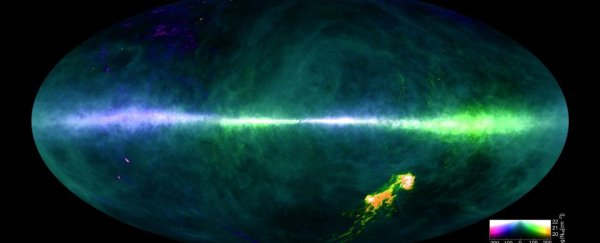It often feels like when people die, they leave a void behind. In the case of massive stars, that happens to be physically true.
A new analysis of the tenuous gas that drifts between the stars in the Milky Way galaxy has revealed the imprint of bubbles that expand into space when a massive star goes supernova at the end of its life. These ghostly traces, scientists say, record a history of star death and the rotation of the Milky Way.
The space between the stars is not entirely empty. In those gaps in space drifts gas, sometimes coming together in more diffuse clouds, mostly of atomic hydrogen. Stars are born in these clouds when they're dense enough; and when they die, stars seed these clouds with the elements they forged in their cores.
How these clouds form and arrange and recycle themselves throughout the galaxy is, however, not completely understood. So a team of astronomers, led by Juan Diego Soler of the Italian National Institute for Astrophysics (INAF) in Italy, set about studying the structures found in the neutral atomic hydrogen that permeates our galaxy.
The team used data collected by the HI4PI project, an all-sky survey that studied the sky in radio wavelengths to obtain a map of the neutral atomic hydrogen throughout the Milky Way.
It's the most detailed survey of its kind conducted so far, mapping not just the distribution of the galaxy's hydrogen, but its velocity as well. By combining this with a model of the Milky Way's rotation, the researchers can gauge the distance to structures in the gas.
With these data, the team employed an algorithm commonly used to analyze satellite photos, teasing out fine structures in the hydrogen that would have been impossible to identify by eye.
These consisted of an extensive network of fine threads of gas known as filaments, those close to the disk mostly perpendicular to the plane of the Milky Way galaxy; those that weren't perpendicular seemed randomly oriented. At greater distances from the disk of the Milky Way, beyond about 33,000 light-years, the filaments were mostly parallel to the galactic plane.
The team interpreted these networks as the imprint of supernova feedback in the gas of the Milky Way.
"These are likely the remnants of multiple supernovae explosions that sweep up the gas and form bubbles that pop when they reach the characteristic scale of the galactic plane, like the bubbles that reach the surface in a glass of sparkling wine," said astronomer Ralf Klessen of Heidelberg University in Germany.
"The fact that we see mostly horizontal structures in the outer Milky Way, where there is a strong decrease in the number of massive stars and consequently fewer supernovae, suggests that we are registering the energy and momentum input from stars shaping the gas in our galaxy."
This, the team said, could offer a new probe for understanding the dynamical processes that shaped the disk of the Milky Way, and a tool for conducting galactic archaeology – studying the fossils of ancient processes to reconstruct our galaxy's history.
It also offers a new context for interpreting other phenomena that may be found in the vicinity of the filaments.
"The interstellar medium, which is the matter and radiation that exist in the space between the stars, is regulated by the formation of stars and supernovae, with the latter being the violent explosions that occur during the last evolutionary stages of stars that are more than ten times more massive than the Sun," said astronomer Patrick Hennebelle of the Saclay Nuclear Research Center in France.
"Associations of supernovae are very efficient at sustaining turbulence and lifting the gas in a stratified disk. The finding of these filamentary structures in the atomic hydrogen is an important step in understanding the process responsible for the galaxy-scale star formation."
The research has been published in Astronomy & Astrophysics.
